|
|
|
 |
 |
 |
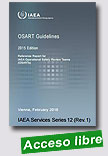 |
OSART Guidelines - 2015 Edition — Reference Report for IAEA Operational Safety Review Teams (OSARTs)
IAEA Services Series, 2016, 67 p.
The IAEA Operational Safety Review Team (OSART) programme provides advice and assistance to Member States to enhance the safety of nuclear power plants during commissioning and operation. The OSART programme, initiated in 1982, is available to all Member States with nuclear power plants under commissioning or in operation. Conservative design, careful manufacture and sound
|
construction are all prerequisites for the safe operation of nuclear power plants. However, the safety of the plant also depends ultimately on: sound management, policies, procedures, processes and practices; the capability and reliability of commissioning and operating personnel; comprehensive instructions; sound accident management and emergency preparedness; and adequate resources. Finally, a positive attitude and conscientiousness on the part of all staff in discharging their responsibilities is important to safety.
The OSART programme is based on the safety standards applicable to nuclear power plants. IAEA safety standards reflect the consensus of Member States on nuclear safety matters. The reports of the International Nuclear Safety Group identify important current nuclear safety issues and also serve as references during an OSART review. The publication OSART Guidelines provides overall guidance on the conduct of OSART missions for both the review experts and their plant counterparts to ensure the consistency and comprehensiveness of the operational safety review.
OSART reviews are performance oriented in that they accept different approaches to commissioning and operational safety that represent good practices and may contribute to ensuring a good safety performance for the operating organization. Recommendations are made on items which are so far not covered by the safety standards, and proposed suggestions might help to find more effective ways to ensure, and further enhance, plant safety. Recognition is also given to the efforts made by the plant to develop and implement an action plan for specific safety improvements identified prior to the IAEA mission. Commendable good practices identified at plants are registered in an IAEA database, to which access is provided to other plants to put in place operational safety improvements worldwide.
This publication updates OSART Guidelines (2005 Edition).
Extraído de: http://www-pub.iaea.org/MTCD/Publications/PDF/SVS12Rev1Web.pdf
|
 |
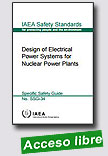 |
Design of Electrical Power Systems for Nuclear Power Plants
IAEA Safety Standards Series, 2016, 120 p.
This Safety Guide provides recommendations on the necessary characteristics of electrical power systems for nuclear power plants, and of the processes for developing these systems, in order to meet the safety requirements of IAEA Safety Standards Series No. SSR-2/1 (Rev. 1). It reflects the changes that have been made to SSR-2/1, in particular to Requirement 68 on Emergency Power Supply.
|
Extraído de: http://www-pub.iaea.org/books/IAEABooks/10688/Design-of-Electrical-Power-Systems-for-Nuclear-Power-Plants
|
 |
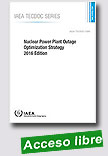 |
Nuclear Power Plant Outage Optimization Strategy: 2016 Edition
IAEA TECDOC, 2016, 110 p
Nuclear power plant outage management is a key factor for safe and economic nuclear power plant performance. This publication discusses plant outage strategy and how this strategy is actually implemented. The main areas that are important for outage optimization that were identified by the utilities and government organizations participating in this report are: 1) organization and management; 2) outage
|
planning and preparation; 3) outage execution; 4) safety outage review; and 5) counter measures to avoid the extension of outages and to facilitate the work in forced outages. Good outage management practices cover many different areas of work and this publication aims to communicate these good practices in a way that they can be used effectively by operators and utilities.
This is an update of TECDOC-1315, published 2002.
Extraído de: http://www-pub.iaea.org/books/IAEABooks/11099/Nuclear-Power-Plant-Outage-Optimization-Strategy-2016-Edition
|
 |
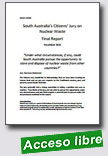 |
Citizens’ Jury Two was held over three weekends in October and November with more than 300 jurors examining the question ‘under what circumstances, if any, could South Australia pursue the opportunity to store and dispose of nuclear waste from other countries?’
The jury handed down its findings to Premier Jay Weatherill on
|
Sunday, 6 November. The report will be a key input to the Governments response to the Royal Commission Report at the end of the year.
Extraído de: http://nuclear.yoursay.sa.gov.au/ |
 |
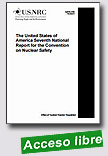 |
The United States of America National Report for the Convention on Nuclear Safety: Seventh National Report
U. S. Nuclear Regulatory Commission, October 2016, 353 p.
The U.S. Nuclear Regulatory Commission has prepared Revision 6 to NUREG-1650, "The United States of America Seventh National Report for the Convention on Nuclear Safety," for submission for peer review at the seventh review meeting of the Convention on Nuclear Safety, to be convened at the International Atomic Energy Agency in Vienna, Austria, in March 2017. This report addresses the safety of land-based
|
commercial nuclear power plants in the United States. It demonstrates how the U.S. Government achieves and maintains a high level of nuclear safety worldwide by enhancing national measures and international cooperation, and by meeting the obligations of all the articles established by the Convention. These articles address the safety of existing nuclear installations, the legislative and regulatory framework, the regulatory body, responsibility of the licensee, the priority given to safety, financial and human resources, human factors, quality assurance, assessment and verification of safety, radiation protection, emergency preparedness, siting, design and construction, and operation. This report also addresses the principles of the Vienna Declaration adopted by the Contracting Parties in February 2015.
Similar to the U.S. National Report issued in 2013, this revised document includes a section developed by the Institute of Nuclear Power Operations describing work that the U.S. nuclear industry has done to ensure safety. The primary responsibility for the safety of a nuclear installation rests with the license holder; therefore, Part 3 explains how the nuclear industry maintains and improves nuclear safety.
Extraído de: http://www.nrc.gov/reading-rm/doc-collections/nuregs/staff/sr1650/r6/#abs
|
 |
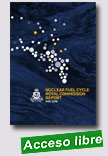
|
Nuclear Fuel Cycle Royal Commission Report
Nuclear Fuel Cycle Royal Commission - South Australian Government South, May 2016, 344 p.
Australia can safely increase its participation in nuclear activities. Such participation brings social, environmental, safety and financial risks. The state is already managing
some of these risks, and the remainder are manageable.
Some new nuclear fuel cycle activities are viable. One in particular, the disposal of international used fuel and intermediate level waste, could provide significant and |
enduring economic benefits to the South Australian community.
Viability analysis undertaken for the Commission determined that a waste disposal facility could generate more than $100 billion income in excess of expenditure (including a $32 billion reserve fund for facility closure and ongoing monitoring) over the 120-year life of the project (or $51 billion discounted at 4 per cent). Given the significance of the potential revenue and the extended project timeframes, the Commission has found that were such a project to proceed, it must be owned and controlled by the state government, and that the wealth generated should be preserved and equitably shared for current and future generations of South Australians. This presents an opportunity that should be pursued.
Social consent is fundamental to undertaking any new nuclear project. Social consent requires sufficient public support in South Australia to proceed with legislating, planning and implementing a project. Local community consent is required to host a facility. In the event that this involves regional, remote and Aboriginal communities, consent processes must account for their particular values and concerns. Political bipartisanship and stable government policy are also essential. This is particularly important given the long-term operation of facilities and the need for certainty for potential client nations.
Extraído de: http://yoursay.sa.gov.au/system/NFCRC_Final_Report_Web.pdf
|
 |
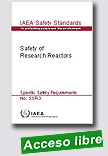 |
Safety of Research Reactors
IAEA Safety Standards Series, 2016, 125 p.
This Safety Requirements publication establishes requirements for all main areas of safety for research reactors, with particular emphasis on requirements for design and operation. It explains the safety objectives and concepts that form the basis for safety and safety assessment for all stages in the lifetime of a research reactor. Technical and administrative requirements for the safety of new research reactors are established in accordance with these objectives
|
and concepts, and they are to be applied to the extent practicable for existing research reactors. The safety requirements established in this publication for the management of safety and regulatory supervision apply to site evaluation, design, manufacturing, construction, commissioning, operation (including utilization and modification), and planning for decommissioning of research reactors (including critical assemblies and subcritical assemblies). The publication is intended for use by regulatory bodies and other organizations with responsibilities in these areas and in safety analysis, verification and review, and the provision of technical support.
Extraído de: http://www-pub.iaea.org/books/IAEABooks/11031/Safety-of-Research-Reactor
|
 |
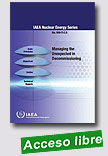 |
Managing the Unexpected in Decommissioning
IAEA Nuclear Energy Series, 2016, 157 p.
This publication explores the implications of decommissioning in the light of unexpected events and the trade-off between activities to reduce them and factors militating against any such extra work. It classifies and sets out some instances where unexpected findings in a decommissioning programme led to a need to either stop, or reconsider the work, re-think the options, or move forward on a different path. It provides practical guidance in planning and management of .
|
decommissioning taking into account unexpected events. This guidance includes an evaluation of the experience and lessons learned in tackling decommissioning that is often neglected. Thus it will enable future decommissioning teams to adopt the relevant lessons to reduce additional costs, time delays and radiation exposures
Extraído de: http://www-pub.iaea.org/books/IAEABooks/10786/Managing-the-Unexpected-in-Decommissioning
|
 |
|
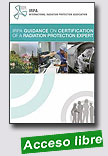
|
IRPA Guidance on Certification of a Radiation Protection Expert - Edition 2016
International Radiation Protection Association (IRPA), 2016, 54 p.
There is a broad expectation from society that persons influencing safety-related decisions and actions have an appropriate level of expertise and competence such that society has confidence in the judgements, advice and decisions. This will ensure the necessary protection of all persons impacted. It would be usual for such decisions and
|
advice to be made within a comprehensive legal framework, usually by organisations which are subject to regulatory oversight and scrutiny. It is increasingly recognised that formal schemes for the recognition of the expertise and competence of individual practitioners involved in critical advice, guidance and decisions in a safety-sensitive situation is an important contribution to ensuring the safe conduct of such activities.
Radiation safety is an integral part of this picture, and it is essential that radiation protection practitioners at all levels are appropriately equipped in terms of knowledge, skills, competences, and experience to discharge their responsibilities and ensure safety.
The International Radiation Protection Association (IRPA) has declared the following Mission Statement: IRPA is the international professional association for radiation protection. It promotes excellence in the practice of radiation protection through national and regional Associate Societies and radiation protection professionals by providing benchmarks of good practice and enhancing professional competence and networking. It promotes the application of the highest standards of professional conduct, knowledge, skills and competences for the benefit of individuals and society. Hence it is one of IRPA’s major goals ‘to promote excellence in radiation protection professionals’. In line with this goal, many of IRPA’s Associate Societies (AS) around the world are actively involved in schemes which assess and certify the competence of individual radiation protection practitioners to undertake safety-related work. Noting that there is a growing pressure, largely from a regulatory perspective, to enhance this approach, many other AS are considering introducing such schemes in the future. Alternatively, regulatory bodies might consider this guidance for introducing appropriate schemes in their country.
Experience has shown that there is no common, unique ‘best practice’ approach to the certification of expertise. Existing schemes differ in many dimensions, for example in scope of application, knowledge and experience requirements and assessment methods, in part due to the need for alignment with national regulatory requirements and also due to established regional/national practices. The objective of this IRPA Guidance Document is not to offer a single template of how to establish a certification scheme, but rather to explore and describe the different options and approaches, to identify their respective strengths and weaknesses, and to outline the key considerations which must be taken into account when introducing and establishing such schemes.
Extraído de: http://www.irpa.net/members/IRPA%20GUIDANCE%20ON%
20CERTIFICATION%20OF%20A%20RADIATION%
20PROTECTION%20EXPERT%202016.pdf
|
 |
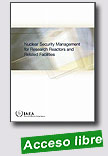 |
Nuclear Security Management for Research Reactors and Related Facilities
IAEA Non-serial Publications, 2016, 84 p.
This publication provides a single source guidance to assist those responsible for the implementation of nuclear security measures at research reactors and associated facilities (RRAF) in developing and maintaining an effective and comprehensive programme covering all aspects of nuclear security on the site. It is based on national experience and practices as well as on publications in the field of nuclear |
management and security. The scope includes security operations, security processes, and security forces and their relationship with the State’s nuclear security regime. The guidance is provided for consideration by States, competent authorities and operators.
Extraído de: http://www-pub.iaea.org/books/IAEABooks/10977/Nuclear-Security-Management-for-Research-Reactors-and-Related-Facilities
|
 |
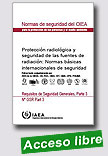 |
Protección Radiológica y Seguridad de las Fuentes de Radiación: Normas Básicas Internacionales de Seguridad
Colección de normas de seguridad del OIEA, 2016, 492 p.
Las presentes Normas establecen requisitos para la protección de las personas y el medio ambiente contra los efectos nocivos de la radiación ionizante y para la seguridad de las fuentes de radiación.
|
|
 |
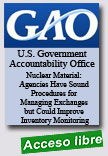 |
Nuclear Material: Agencies Have Sound Procedures for Managing Exchanges but Could Improve Inventory Monitoring
Government Accountability Office (GAO - US), Sep 23, 2016, 40 p.
The United States must generally account for nuclear material it has obtained under nuclear cooperation agreements with foreign partners. The agreements generally impose certain conditions, including that the material be used for peaceful purposes. Material subject to such conditions is called
|
“obligated.” The United States relies on NMMSS to track obligated material and to help demonstrate U.S. compliance with agreements. Material not subject to agreement conditions is called “unobligated.” Some forms of uranium, such as LEU, are used to maintain the nuclear weapons in the U.S. stockpile, but the U.S. inventory of unobligated LEU is declining.
GAO was asked to review the practice of obligation exchanges and the reliability of certain NMMSS data. This report examines (1) the number of obligation exchanges in the United States since 2003, and the reasons for them, and (2) how DOE and NRC ensure such exchanges are accurately tracked and reported through NMMSS. GAO analyzed NMMSS data and agency documents and interviewed agency officials, DOE contractors, and NRC licensees, among other steps.
Report
Extraído de: http://www.gao.gov/products/GAO-16-713?utm_medium=email&utm_source=govdelivery
|
| |
| |
|
|
| |
| |
|
|
|
|
|
|
|
